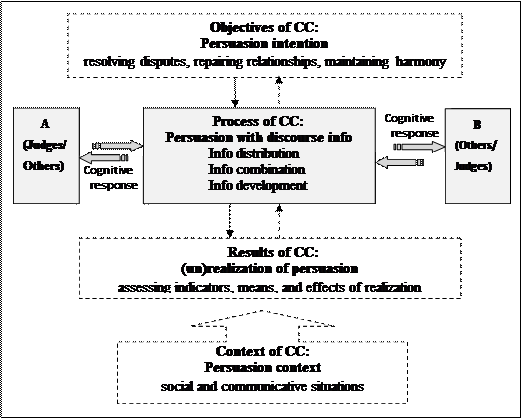On the basis of the theoretical ground and in light of the working definitions of CC and persuasion, by incorporating systematical findings of discourse information from the Tree Model and concrete components of the context model, the theoretical framework “the Discourse-Information-Centric Model of Persuasion” (DICMP) in the present study is constructed to guide the discussion of persuasion in CC.
In the DICMP, persuasion in CC is viewed from two angles. Firstly, it is regarded as a process of persuasion, where discourse information is exchanged between participants and cognitive responses are yielded. Secondly, it is regarded as a complicated process to achieve objectives of CC by means of persuasion through discourse information. In other words, persuasion in CC is viewed both as a series of discourse information exchanges between parties and as a series of discursive practice.

Figure 3‑2 The Discourse-Information-Centric Model of Persuasion (DICMP)
As shown above, from the horizontal angle, in the upper middle part of the figure lie three boxes with solid lines which represent participants and discourse information. The solid lines indicate that persuasion in CC is a salient talk activities between two participants who take discourse information as the major medium of communication. Actual distributions, combinations and development of discourse information record the discursive practice of persuasion and reveal participants’ cognitive responses from which one participant may know whether the other is persuaded.
The pairs of right and left arrows represent interactions between participants. The letters A and B represent a slot of participants in CC, which can be filled either by judges or other participants (the plaintiff, the defendant, or the attorney per se, and sometimes, two or all of them as a whole). Specifically, persuasion in CC may occur between judges and a single party or both parties to the case, between the plaintiff and the defendant, or between a party and his attorney. Hence, the DICMP reveals the complexity of participants and encompasses interactions between parties in CC which is quite rare in court investigation and court debate.
From the vertical angle, two boxes with dotted lines are put at the both ends of the discourse information, showing that persuasion in CC can be implicitly considered as a process in which participants resort to discourse information to achieve their objectives. The dotted lines imply that compared with detailed exchanges of discourse information, the objectives and the results of CC turn out to be rather implicit. Nonetheless, they influence the distributions, organizations and development of discourse information.
Objectives of CC generally include resolving disputes, repairing relationships and maintaining harmony. The downward solid arrows indicate that a particular persuasion intention will influence the development of discourse information. From the detailed discourse information which reflects cognitive responses participants can learn whether persuasion has been realized. Since the initial persuasion intention may not be realized instantly, the upward dotted arrows indicate that the result of CC may have counter-impacts on discourse information which in turn may result in the adjustment of objectives of CC.
Besides, the bigger dotted arrow at the bottom of the theoretical framework represents the persuasion context, implying that it influences the whole process of persuasion. It is further divided into social situations which include settings, social roles and social relations, and communicative situations which encompass communicative roles, intentions and goals and knowledge.
To sum up, in the above theoretical framework DICMP, persuasion in CC is viewed as salient and implicit cognitive interactions which are centered on discourse information. In other words, persuasion in CC is discourse-information-centric. Gaining insights from the findings of the Tree Model of discourse information, the distribution, combination and development of discourse information in particular, persuasion in CC can be analyzed in a much more systematical and comprehensive way. Besides, persuasion in CC is under the influence of the persuasion context which can be decomposed into social and communicative situations which can be further divided into sub-categories. It not only stresses the very social and cognitive nature of the persuasion context, that is, dynamically and subjectively constructed, but also makes the detailed exploration of factors in the persuasion context that may influence persuasion more practical.
Under the guidance of the theoretical framework DICMP, chapters 4 to 6 will focus on the exploration of discourse information, the persuasion context and the realization of persuasion respectively. Due to space limit, in this dissertation, we mainly focus on judges’ talk activities, that is, how judges persuade parties through discourse information in CC.
